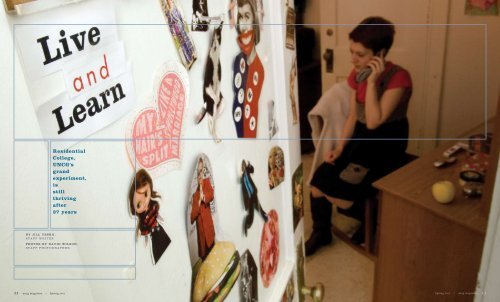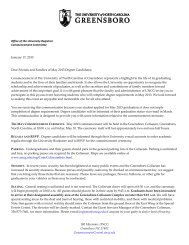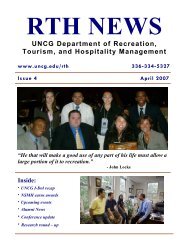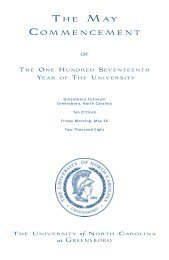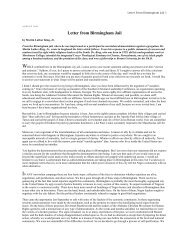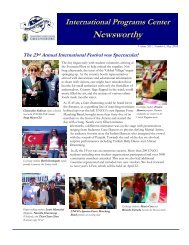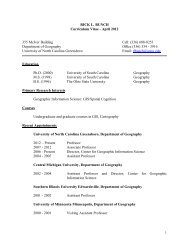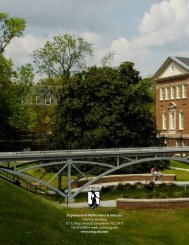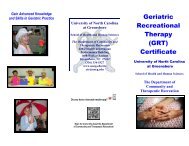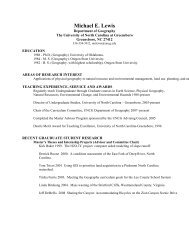Residential College, UNCG's grand experiment, is still thriving after ...
Residential College, UNCG's grand experiment, is still thriving after ...
Residential College, UNCG's grand experiment, is still thriving after ...
You also want an ePaper? Increase the reach of your titles
YUMPU automatically turns print PDFs into web optimized ePapers that Google loves.
<strong>Residential</strong><br />
<strong>College</strong>,<br />
UNCG’s<br />
<strong>grand</strong><br />
<strong>experiment</strong>,<br />
<strong>is</strong><br />
<strong>still</strong><br />
<strong>thriving</strong><br />
<strong>after</strong><br />
37 years<br />
B y J i l l Y e s k o ,<br />
s t a f f w r i t e r<br />
p h o t o s b y D a v i d W i l s o n ,<br />
s t a f f p h o t o g r a p h e r<br />
22 uncg magazine ° Spring 2007<br />
Spring 2007 ° uncg magazine 23<br />
Spring 2007 ° uncg magazine 23
T h e o p e n i n g n o t e s o f J i m m y B u f f e t t ’ s<br />
laid-back anthem “Margaritaville” play in the background as<br />
Meredith Miller strolls through the third-floor hallway of Mary<br />
Foust Hall. On the way to her room, she passes doorway <strong>after</strong><br />
doorway festooned with colorful art projects, endless photographs<br />
of friends and pets, well-used message boards. A pirate<br />
flag and ceramic duck complete the ornamentation. Two students<br />
lounge on their bellies typing away on their laptops. A<br />
bicycle frame waiting to be painted sits by a door surrounded<br />
by scraps of sandpaper. Another student proudly shows off h<strong>is</strong><br />
private office, a computer and tidy bookshelf inside a closet.<br />
It’s as if YouTube and MySpace have come to life.<br />
Welcome to Mary Foust, home of <strong>Residential</strong> <strong>College</strong>, UNCG’s<br />
oldest and arguably most eclectic learning community. Establ<strong>is</strong>hed in<br />
1970 as the brainchild of ideal<strong>is</strong>tic philosophy professor Warren Ashby,<br />
<strong>Residential</strong> <strong>College</strong> (or RC as everyone calls it) quickly became one of<br />
the most iconic elements in UNCG’s commitment to creating an environment<br />
where students and faculty can live and learn in a funky, collegial<br />
setting.<br />
As one of the first residential colleges to be establ<strong>is</strong>hed in the United<br />
States, RC pioneered learning environments where classes are linked to<br />
an interd<strong>is</strong>ciplinary theme and where students and faculty learn from<br />
each other in intimate settings. What started as Ashby’s radical notion of a<br />
“college within a college” has turned into a full-scale academic movement<br />
— with UNCG leading the way.<br />
The vibe for the 120 students at <strong>Residential</strong> <strong>College</strong> <strong>is</strong> earthycrunchy<br />
meets intellectually curious. Students at RC are “into” everything<br />
from ra<strong>is</strong>ing awareness about famine in the Darfur region of<br />
Africa to exploring how detective fiction serves as a metaphor for <strong>is</strong>sues<br />
in modern-day society. “As soon as you walk into Mary Foust Hall you<br />
know you are in a place that has character,” says Meredith, a junior<br />
majoring in h<strong>is</strong>tory. “And characters are definitely honored and welcomed<br />
here!”<br />
RC’s charm comes from its almost mandated informality. Camaraderie<br />
between faculty and students comes easily, especially when classes are<br />
held on the worn couches and threadbare easy chairs of Ashby parlor.<br />
Some classes are held in the basement’s game room or on the outside<br />
lawn.<br />
“Faculty members don’t get rooms with rows of desks,” declares<br />
Dr. Fran Arndt, RC’s plainspoken “godmother” who has taught there<br />
for more than three decades. Sitting in her office under a banner reading<br />
”Well Behaved Women Rarely Make H<strong>is</strong>tory,” Arndt observes that from<br />
day one, RC students are “already thinking outside of the box.”<br />
Class act<br />
On a late autumn day, 20 students (RC mandates that classes are capped at<br />
24 students) l<strong>is</strong>ten as Chr<strong>is</strong>tine Flood, a lecturer in the h<strong>is</strong>tory department,<br />
d<strong>is</strong>cusses h<strong>is</strong>torical context during her “Show Me the Money” seminar<br />
exploring popul<strong>is</strong>m and prosperity in America in the 20th century. While<br />
1970<br />
As the university has grown in size there has<br />
been the increasing feeling on the part of students<br />
that they have become an unidentifiable<br />
part of an impersonal, bureaucratic machine.<br />
For the student, the IBM card has become the<br />
omni-present symbol of th<strong>is</strong> feeling.<br />
— From “Proposal to Establ<strong>is</strong>h a Living/Learning<br />
Unit” for what was to become <strong>Residential</strong> <strong>College</strong><br />
The proposal was anything but modest. To<br />
create an “inner college” where freshman and<br />
sophomore women and men would share a<br />
core curriculum, attend class together and<br />
even call their professors by their first names<br />
— to their faces — all the while living under<br />
one roof.<br />
The year was 1970, and the radical <strong>experiment</strong><br />
was called simply <strong>Residential</strong> <strong>College</strong>. RC grew<br />
out of the tumultuous 1960s, a time of upheaval<br />
on campuses across the United States. The<br />
Vietnam War was <strong>still</strong> raging, and students<br />
from coast to coast were clamoring for greater<br />
“relevancy” from their college experiences.<br />
Change was in the air: The time was right for<br />
something new and different to emerge.<br />
RC was the brainchild D r . W a r r e n A s h b y ,<br />
an ideal<strong>is</strong>tic philosophy professor who championed<br />
the cause of what was to become a mainstay<br />
on campus. In 1970, residential colleges<br />
ex<strong>is</strong>ted in England, but American residential colleges<br />
were few and far between outside of Ivy<br />
Leagues schools such as Yale and Harvard.<br />
Far left, Mary Foust Hall, circa 1970<br />
24 uncg magazine ° Spring 2007 Spring 2007 ° uncg magazine 25
Live<br />
and<br />
Learn<br />
some students scribble notes, most l<strong>is</strong>ten; some even knit. No one sends<br />
text messages. No one looks bored.<br />
Ambling up to a lectern in stocking feet, students give end-of-semester<br />
reports on topics such as the effects of rapid industrialization during the<br />
Gilded Age or the role of social<strong>is</strong>t and political leader Eugene V. Debs.<br />
Flood l<strong>is</strong>tens from the sidelines as students easily banter back and forth<br />
questioning and debating what they’ve just heard.<br />
“Students feel free to speak out in class and engage,” Flood says. “They<br />
have a comfort level with each other.” While it may all look easy, Flood,<br />
who also teaches American h<strong>is</strong>tory classes for non-RC students, admits<br />
that “interd<strong>is</strong>ciplinary <strong>is</strong> hard to do,” in part because not all faculty members<br />
are comfortable team teaching a multid<strong>is</strong>ciplinary curriculum.<br />
Still, for those who are game, teaching at RC <strong>is</strong> a rewarding experience.<br />
“It’s like a little family,” says Dr. Jay Lennartson, ass<strong>is</strong>tant professor of<br />
geography who teaches earth science and sustainability classes in RC.<br />
“The students are much more<br />
passionate about learning and<br />
they have a great respect for<br />
each other. As a teacher, I feel<br />
a lot of love and appreciation.”<br />
Where everybody knows your name<br />
To be admitted, you have to be a little bit different, but in a good way. As<br />
part of the application, potential students have sent ballet slipper ribbons,<br />
forks bent into yoga postures, poems, paintings and links to personal web<br />
sites. “You have to go that extra mile to get into RC,” says Meredith Miller.<br />
Those who apply must not only be committed to academics, but also to<br />
participating in the running of <strong>Residential</strong> <strong>College</strong>. To that end, students<br />
have an unprecedented voice, even helping to say yay or nay to who will<br />
be admitted.<br />
In addition to a 22-person council that oversees academic policy, students<br />
can join a multitude of committees and activities that include a parlor<br />
theatre, gardening (one student’s parents donated a composter to use<br />
in the student-run garden), literary magazine, intramurals and numerous<br />
service-learning projects.<br />
Over the years, RCers have held community Thanksgiving dinners,<br />
inviting members of the Mary Foust housekeeping staff as well as others<br />
connected to RC. Their annual haunted house ra<strong>is</strong>es money for<br />
charity and allows students’ creative impulses to run wild. Last year’s<br />
theme was Dante’s Inferno. Other themes have included psychiatric<br />
hospitals and a haunted circus. A green, chest-high paper-mâché mask<br />
dubbed “Josephine,” a remnant of a former haunted house’s décor, gets<br />
trotted out for special occasions. Over the years, Mary Foust has seen<br />
weddings, a bapt<strong>is</strong>m, memorial services and birthday parties for the<br />
children of the residential counselors, along with innumerable spontaneous<br />
celebrations.<br />
And then there’s Valle Cruc<strong>is</strong>, a retreat center outside of Boone in western<br />
North Carolina where students, alumni, faculty and staff partake in a<br />
bi-annual pilgrimage to get away from it all. The time away includes mandatory<br />
guitar playing, poetry readings, nature walks and time-honored<br />
games such as sardines, a kind of hide-and-seek in reverse where students<br />
hide in a group.<br />
Michael Riley, ass<strong>is</strong>tant professor of Engl<strong>is</strong>h,<br />
teaches class in the parlor in 1971.<br />
Many students believe that their<br />
university experience would be<br />
more rewarding if they simply<br />
knew better the people — students<br />
as well as teachers — with<br />
whom they worked.<br />
— From “Proposal to Establ<strong>is</strong>h a<br />
Living/Learning Unit”<br />
What was new for the first students<br />
— and what <strong>is</strong> <strong>still</strong> unique<br />
today — <strong>is</strong> RC’s fierce dedication<br />
to building bridges between faculty<br />
and students. RC’s freshmen<br />
and sophomores all follow a core<br />
curriculum exclusive to RC team<br />
taught by faculty from a variety of<br />
d<strong>is</strong>ciplines. Classes, which are<br />
held in intimate seminars, are<br />
clustered around a broad-based<br />
theme that keeps students learning<br />
together for four semesters.<br />
Last year’s core curriculum was<br />
“The American Experience 1900-<br />
2000” — a theme that could have<br />
proven lethally boring were it not<br />
for courses with attention-grabbing<br />
titles such as or “Hollywood<br />
and H<strong>is</strong>tory: Truth, Lies and<br />
Videotape” or “A Woman’s Work<br />
Is Never Done” and dedicated<br />
faculty. “The experience here <strong>is</strong><br />
on class work that demands<br />
thought,” Dr. Fran Arndt says.<br />
“RC students are already thinking<br />
outside of the box.”<br />
26 uncg magazine ° Spring 2007 Spring 2007 ° uncg magazine 27
Live<br />
and<br />
Learn<br />
“Faculty have so many pressures on them now. It’s hard for them to<br />
socialize with students,” says Jeanne Aaroe ’81, ’95, ’00, ’05 MLS, RC’s<br />
ass<strong>is</strong>tant director. And it‘s the bonding that faculty and students say <strong>is</strong><br />
key to RC’s enduring appeal. “Students may not remember all that they<br />
learn in classes,” Arndt says. “But they certainly remember the friendships<br />
they’ve made.”<br />
Because the core curriculum accounts for about half of their schedules,<br />
students must leave the Mary Foust womb to take additional<br />
classes or to shop, go to the dining hall and reconnect with the world<br />
outside. Still, with a kitchen, computer lab, game room and plethora of<br />
in-house activities, many say they are reluctant to look for stimulation<br />
outside the walls of Mary Foust. “You only really have to go outside to<br />
go to the library and to buy food,” says Meredith. “Socially, it’s very<br />
easy to hang out. There are 120 people here, and I’ve talked to all of<br />
them at least once.”<br />
While some may wonder if RC breeds a culture of insularity (students<br />
had T-shirts made up reading “Mary Foust: Where Everybody<br />
Knows Your Name and All Your Business”), students say that keeping<br />
it all in the family <strong>is</strong> exactly what they were <strong>after</strong> when they enrolled<br />
at RC.<br />
“I really like the culture here,” says sophomore Zach Shuford, an<br />
avid rock climber who transferred to RC <strong>after</strong> h<strong>is</strong> freshman year. “It’s all<br />
part of living together. When we walk out of class we can continue d<strong>is</strong>cussions<br />
in our rooms. I love th<strong>is</strong> place.”<br />
“Each person’s RC experience <strong>is</strong> different,” adds Anders Selhorst,<br />
’00, ’04 MLIS, who likens h<strong>is</strong> years there to those of Harry Potter at<br />
Hogwarts. “We don’t have a Dumbledore,” says Anders, “[but] you do<br />
have some interesting characters.” g<br />
Going Strong<br />
Strong and Grogan <strong>College</strong>s and<br />
the <strong>Residential</strong> <strong>College</strong> legacy<br />
<strong>Residential</strong> <strong>College</strong> grew out of the passion and<br />
ideal<strong>is</strong>m of the 1960s. Interd<strong>is</strong>ciplinary education —<br />
the notion that the arts, sciences and humanities<br />
should be integrated — was on the cutting edge of<br />
college curricula. Th<strong>is</strong> notion was brought to fruition<br />
at UNCG with the opening of RC.<br />
Its success has spawned two other residential<br />
communities, Cornelia Strong <strong>College</strong> and Ione<br />
Grogan <strong>College</strong>. Like <strong>Residential</strong> <strong>College</strong>, they<br />
share the m<strong>is</strong>sion of bringing learning to students in<br />
an intimate environment. Founded in 1994, Strong<br />
<strong>College</strong>, named for Cornelia Strong, who taught<br />
mathematics and astronomy from 1905 to 1948,<br />
allows students to live in community in South<br />
Spencer Hall. Strong students take a full complement<br />
of courses throughout the university.<br />
Strong <strong>College</strong> cons<strong>is</strong>ts of resident students<br />
called “junior fellows,” faculty “senior fellows” and a<br />
flexible number of non-resident upperclassmen and<br />
alumni. Weekly teas and lunches with faculty are<br />
signature Strong <strong>College</strong> activities along with an<br />
annual regatta on Buffalo Creek and a croquet tournament.<br />
In the words of the Strong <strong>College</strong> web<br />
site: “We race miniature boats in an effort to, well,<br />
we’re not sure why we do it, but it sure <strong>is</strong> fun!”<br />
Strong’s weekly coffee bar <strong>is</strong> named <strong>after</strong> the college’s<br />
mascot — a stuffed lemur called Tim.<br />
Founded in 1997 and named for alumna Ione<br />
Grogan ’13, Grogan <strong>College</strong> <strong>is</strong> the youngest of the<br />
three residential colleges. Open only to freshmen,<br />
the Grogan experience <strong>is</strong> a one-year program based<br />
in Grogan Residence Hall. The college <strong>is</strong> divided<br />
into learning communities of 10-25 students organized<br />
around specific topics or areas of interest.<br />
Students in each learning community take at least<br />
one common class together.<br />
“The primary purpose of all learning communities<br />
<strong>is</strong> for students to have a close relationship with<br />
faculty and for faculty to serve as mentors to students,”<br />
says Dr. Kathleen Rountree, associate provost<br />
for undergraduate education. “The constant <strong>is</strong><br />
that students do better when they are engaged in<br />
the university community.”<br />
The more things change,<br />
the more they stay the same<br />
The sound of stringed instruments has<br />
been a part of RC life since its beginning.<br />
In the left photo, Meredith Miller (in pink)<br />
picks out a tune on the banjo while her<br />
hallmates knit, chat and otherw<strong>is</strong>e relax.<br />
Having a small, intimate community was<br />
one of the original goals of RC. The proposal<br />
to establ<strong>is</strong>h the college, states: “It<br />
<strong>is</strong> our feeling that some of the shock that<br />
even the very brightest students experience<br />
when they come to college as freshmen<br />
may be attenuated by becoming part<br />
of a smaller unit.” Keeping things close to<br />
home makes it easy for students to get<br />
involved — both with the life of RC and<br />
with each other. Living together has its<br />
advantages. “As soon as you walk into<br />
Mary Foust Hall you know you are in a<br />
place that has character,” says Meredith.<br />
“And characters are definitely honored<br />
and welcomed here!”<br />
1971<br />
28 uncg magazine ° Spring 2007 Spring 2007 ° uncg magazine 29


